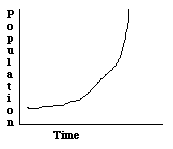 Biotic Potential: The rate at which a
population would grow if every new individual survived to adulthood and reproduced
at its maximum capacity.
Biotic Potential: The rate at which a
population would grow if every new individual survived to adulthood and reproduced
at its maximum capacity.
Population: A group of individuals of the same species (humans, tigers, dandelions, bacteria, etc) that live in a particular area.
Birth and immigration add to a population.
Death and emigration subtract individuals to a population
Immigration: Individuals moving into an area
Emigration: Individuals moving out of an area
What causes creatures to immigrate/emigrate? Lack of resources (food, water shelter), lack of mates, lack of breeding territory, poor weather, too many predators, etc..
Population Increases when:
# of births + # of immigrants > # of deaths + # of emigrants
Population Decreases when:
# of deaths + # of emigrants > # of births + # of immigrants
Most organisms produce more offspring than can survive to grow up and reproduce. Why do they need to produce so many young? To ensure that some survive to breeding age!
 Biotic Potential: The rate at which a
population would grow if every new individual survived to adulthood and reproduced
at its maximum capacity.
Biotic Potential: The rate at which a
population would grow if every new individual survived to adulthood and reproduced
at its maximum capacity.
When a population grows at its maximum rate, it does so exponentially. This is shown by a J-shaped curve on a graph (see graph at right).
Some biotic potentials:
Humans = 6% per year (population doubles every 11 years)
Rats =1.5% per day (400% per year) (pop. doubles every 47 days)
Bacteria = 250 % per hour (doubles every 15-30 minutes)